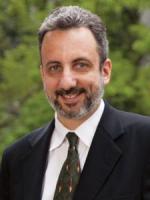Hajjar Awarded $180K NSF Grant

CEE Professor & Chair Jerome Hajjar was awarded $180K NSF Grant for "Transforming Building Structural Resilience through Innovation in Steel Diaphragms". This is part of a $540K grant with John Hopkins University and Virginia Tech.
Steel-framed buildings form an integral part of our nation’s built environment. Understanding the response of these structures to lateral loads is critical to predicting and controlling their impact on society during natural hazards. Decades of investment have greatly increased our understanding of the frames and bracing schemes that provide resistance in the vertical lateral force resisting system. Similar investments have not been made in understanding the diaphragm, i.e., the horizontal lateral force resisting system. This lack of knowledge can be acutely observed in the simplified methods used in diaphragm design, and simplistic models typically employed in predicting diaphragm response. Current knowledge impedes a needed evolution for lateral building design from 2D frames to 3D buildings.
The objectives of this research are: to develop fundamental understanding of steel deck diaphragms as systems, integrate that understanding into accurate building models, utilize those advances to explore and prototype novel steel deck diaphragm solutions, including the integration of energy-dissipating fuses in the diaphragm, provide a means to create optimized response between the vertical and horizontal lateral force resisting system, unlock the potential for 3D building design, and increase building structural resilience.
These ambitious objectives are supported by the research methods which include: development of a series of building archetypes; careful experimentation at the connection and diaphragm scale including novel non-contact measurement schemes for revealing damage and deformations during testing; material and geometric nonlinear finite element models at high fidelity levels to enable detailed investigations of the flow of forces in diaphragms and all connected components, and at low fidelity (reduced order) to develop models appropriate for whole building analysis; formal optimization of the role of the diaphragm in building response including a novel two-level optimization scheme; and, testing of energy-dissipating fuses and development of concept and prototypes for integrating fuses into steel diaphragm systems.
Intellectual Merit
Better understanding and prediction of the 3D response of buildings under lateral loads, such as seismic, is a key advancement towards more resilient buildings. Experiments with novel non-contact measurement techniques and advanced simulations will be combined to understand the diaphragm as a system, including its interaction with framing. The developed modeling protocols will provide an important step towards analysis-based design given that diaphragm models are currently grossly simplified in traditional building modeling. In addition, the modeling is an enabling step for investigations into spatial optimization of the diaphragm details and the addition of energy-dissipating fuses in the diaphragm – two novel concepts for improving building performance through better understanding of the diaphragm. A detailed research plan, including coordination across the schools and with industry, is provided. The team has a positive history of related work and collaboration and is uniquely positioned to perform the proposed work. The team has unique resources at their home institutions, including a recently constructed rig designed specifically for testing steel diaphragms, and is able to complete the proposed experimental and modeling efforts.
Broader Impacts
The proposed research positively impacts our understanding of building response in natural hazards and is directed at improving that response in terms of post-hazard resilience, a key societal objective for our built environment. The research team is allied with industry partners as unfunded collaborators (AISC, AISI, SDI, SJI, and MBMA) providing a means to maximize the impact of the research on engineering practice as well as codes and standards. The team, already with a record of collaboration in research and teaching, will also develop a graduate course module on diaphragms and provide webinars and other educational outreach activities for practicing engineers. The project team will provide an integrated research and education experience for Ph.D., M.S., and undergraduate participants across three schools.